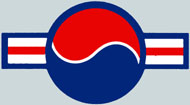
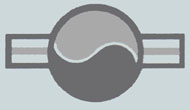 Credit: Roundels of the world
Credit: Roundels of the world Bases


 Credit: Roundels of the world
Credit: Roundels of the world
Bases

Continous tension with North Korea, erupting in an almost state of war, and the friendship with the United States of America influence heavily this country.
Procurement
In 1964 the USA proposed to withdraw a Division stationed in Korea; to sweaten the matter to the Korean goverment it was proposed (among others) to supply the 6th Tactical Squadron with Northrop F-5A. The
withdrawal was suspended.
A
first tentative procurement of a new fighter to replace North Amrican
F-86 Sabre started in 1965 with the plan to operate Lockheed F-104Gs
starting from 1965 to counter North Korean MiG-19 and MiG-21,
but
complexity and USA military aid policy allowed only the supply of the Freedom
Fighter, which was later introduced.
A
total of 88 Northrop F-5A and 20 Northrop F-5B were supplied under MAP
between 1965 and 1972, another 16 F-5B were bought directly.
Military Assistance Program (MAP) F-5As were granted in following US
Fiscal Years: 1963 -
29; 1964 - 3; 1965 - 17; 1966 - 5; 1967 - 14; 1968 - 6; 1970 - 3; 1971
- 10; one is unaccounted. By mid-68 there were
a total of 54 Northrop F-5s in the country.
Pilot training started during 1964 when 4 instructors
were trained in the USA, while deliveries
of F-5s Freedom Fighters began in 05 April 1965; they replaced North
American F-86Fs.Transported to South Korea (fully
fueled and armed, wrapped
in plastic) by ship.
First 20 were unloaded at Jinhae Port port and flown out from the local
base. Official Korrean take-over was on 30-04-65 at Suwon AB.
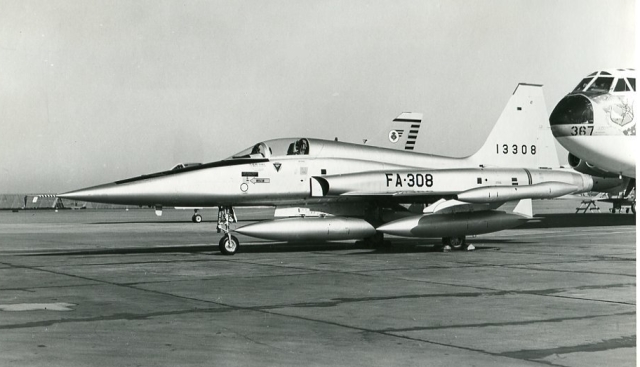

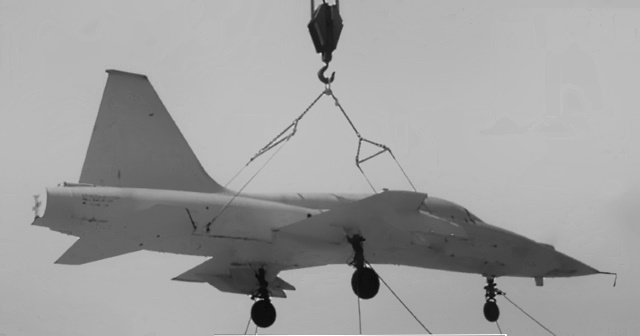

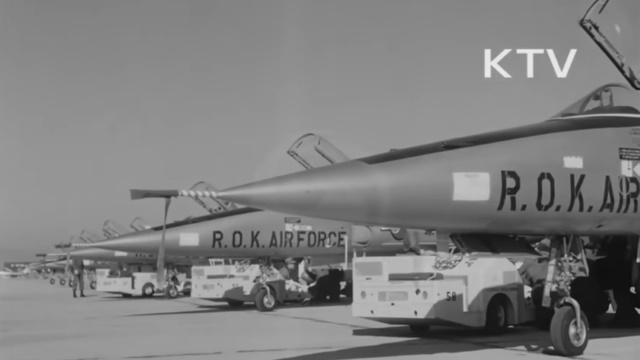 Photo: KTV
Photo: KTV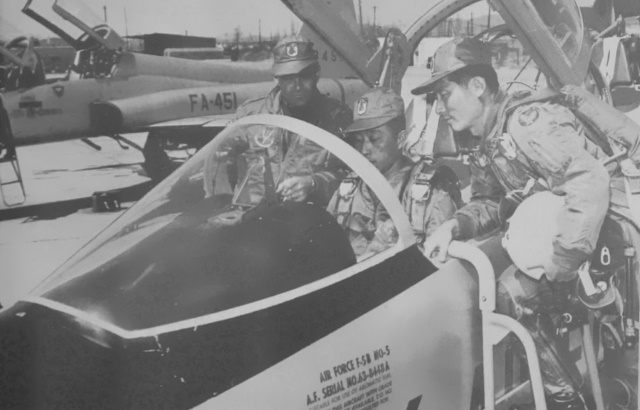
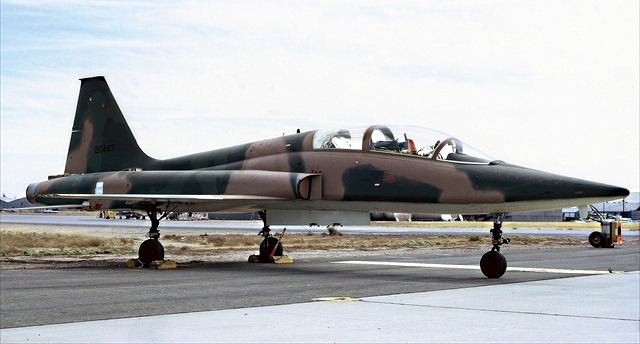 Photo:
Archive The Northrop F-5 Enthusiast
Photo:
Archive The Northrop F-5 Enthusiast The Republic of Korea AF planned originally to buy
McDonnell RF-4E for
reconnaissance purposes, but the plan was abandoned and 8 Northrop
RF-5A were purchased in US Fiscal Year 1971; a former Republic
of
Vietnam AF example was added when this contry collapsed.
The
war in Vietnam brought on 28-10-72 an US request to transfer 48
Northrop F-5As to South Vietnam, under operation "Enhance Plus". These
fighters were to be replaced by Northrop F-5Es as soon as they were
to
be available.
Korea did not agree to this and requested the delivery of 18 McDonnel
F-4D in exchange for the Freedom Fighters. Finally, a compromise
offer was submitted, either to
lease of 18 McDonnel F-4D or to base 2 USAF
McDonnel F-4 Squadrons locally for
the air defence of the country. The first alternative was chosen by
Korea; only 36 F-5A were transferred to South Vietnam, June 1972 saw the introduction of the reconnaissance
Northrop RF-5A.
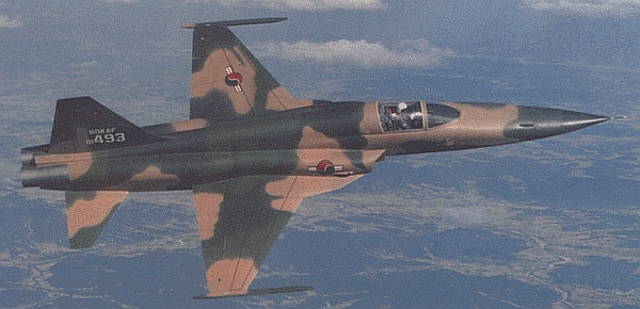 Photo: Northrop
Photo: NorthropIn
June 1974 an oral request was made to the USA for direct purchase from Northrop (instead of co-production) of 54 single- and 6 double-seaters, 30 aircrafts
to be delivered during calender year 1977, an written
request to be sent shortly after. The additional Tigers were to be paid
partially under Foreingn Military Fund and the rest by the country.
Interest
was also shown for
21 "second hand" Tigers flown out of South Vietnam as add-on to the
already scheduled
72 Northrop F-5Es to be delivered via MAP, scheduled to start in
February 1976. These
ex-Vietnamese Tigers might have reduced the number
of new aircrafts needed (see above).
Also
considered was the possibility to divert to Korea, instead to the
Republic of China, 21 new aircrafts originally foreseen for S.
Vietnam (which collapsed). The total of 42 (21 ex SVN/21 new) Northrop F-5Es might
have caused maintenance and financing problems.
All three plans had no follow-on
By April 1976 there were following types on hand: 71 Northrop F-5A, 8 RF-5A, 26 F-5B, 48 F-5E; 2 additional F-5A and 1 RF-5A were foreseen for 1976 delivery (ex Vietnam) together with 8 F-5B bought under Project
According
to an official US list funding was provided for the Security Assistance
Program FY
1976 (or previously) 2 Northrop RF-5A, 12 F-5A, 3 F-5B. Another source
states that 28 Northrop F-5A, 10 Northrop F-5B
were funded.
Reports mention that altogether 21 (or 19) F-5A Freedom Fighter (including former Korean and other nations) used by the Vietnamese AF were returned at the end of the conflict (1975). Fourteen serials are known.
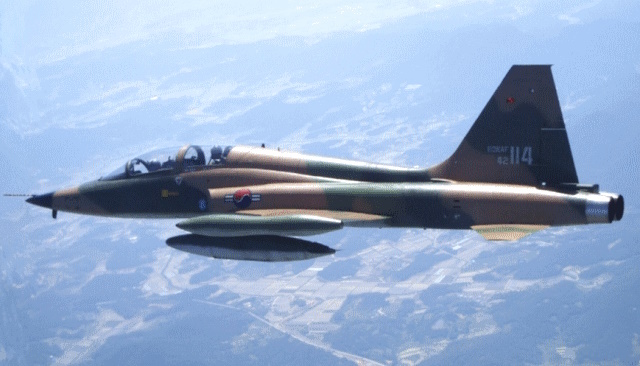 Photo: R.o.Korea AF
Photo: R.o.Korea AF
Air-to-air view of camouflagedNorthrop F-5B serial 42-114 shortly before its withdrawal from use
Withdrawal of the Northrop F-5A/F-5B Freedom Fighter was completed only during the year 2005.
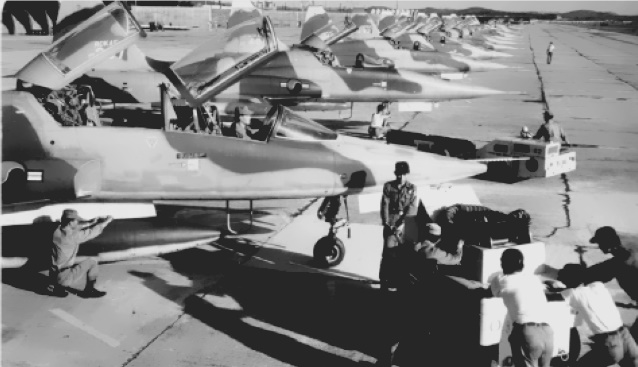
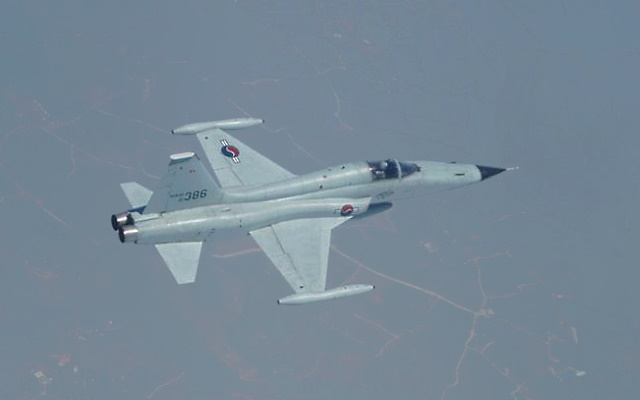
Line-up of camouflaged Northrop F-5B (nearest) and Northrop F-5A (unfortunaley black-and-white photo) Northrop F-5A 01386 seen towards of the end of its carrier, with new grey camouflage
Photos: R.o.Korea AF
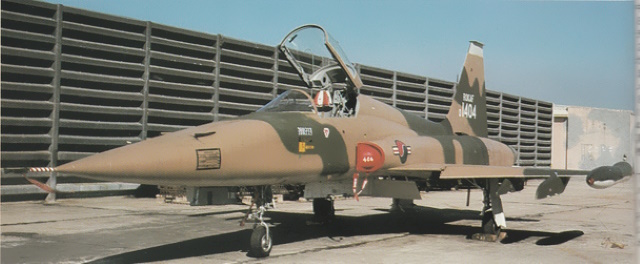 Photo: R.o.Korea AF
Photo: R.o.Korea AF
Camouflaged Northrop
F-5A, serial 63-8434

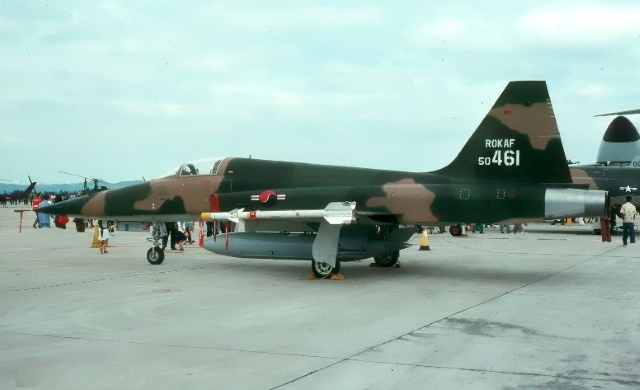
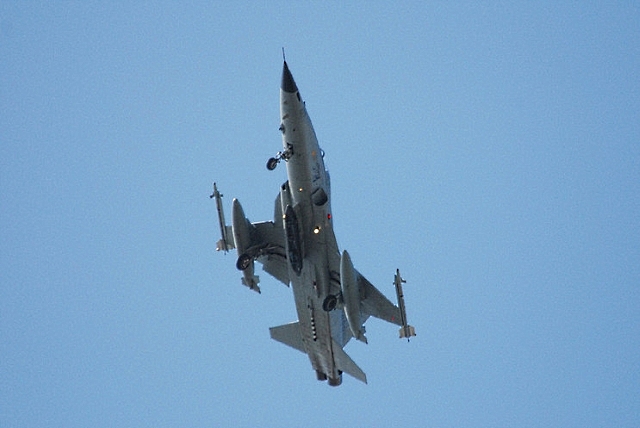
US statics showed in 1982 a total strength of 254 Northrop
F-5A/F-5B/F-5E/F-5F. The Air Force had a slight superiority over the
People's Republic of Korea AF due to better fighters and pilots
training but had
shortages as only 7 days of operations, of ammunitions, fuel and spare parts were available. According to an US source there were, by 2004, a total of 260 aircrafts in service.
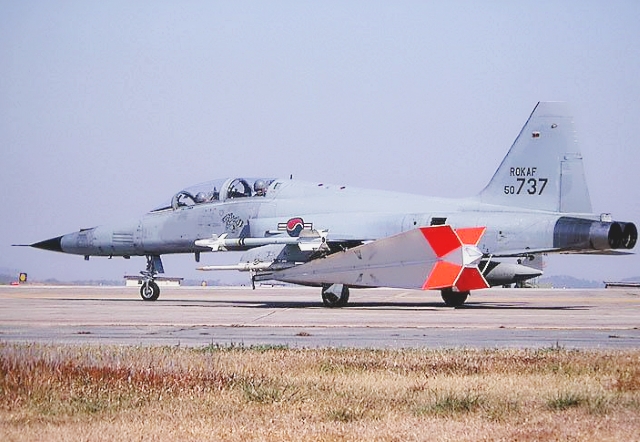
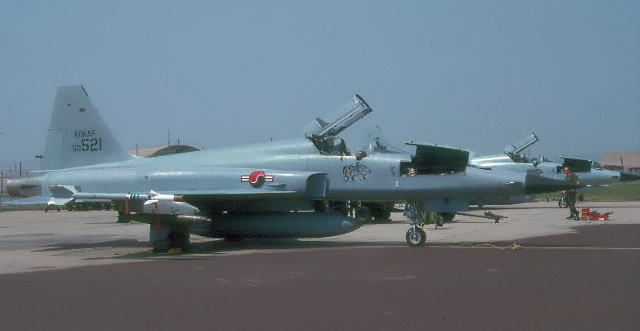
First Northrop built F-5F delivered,
used as Target Tug with AIM-9 Sidewinders in
1990. Northrop F-5E
50521 Sidewinders on wingtips, bombs underwing, tank underfuselage
Typhoon "Rusa" raged on the Base in September 2002 damaging several local based aircrafts, except
10 Tigers. An enormous amount of maintenace was involved to restore the
base to operation; other Tigers were
flooded and personnel from other
units, as well as American personnell, wasneeded to overhaul and assemble them.
Involvement of local Industry/Upgrade
A
first attempt for local production was made in 1974 when three US
aircrafts companies competed for
co-assembly/local production of a new fighter. The
Korean government selected in 1975 the Northrop F-5E,
(though the
original request was for General Dynamics F-16 or Chance-Vought A-7,
authorisation refused by the USA government) for anacquisition of 60
fighters; a
Northrop team had confirmed in July-August 1974
the fully
feasibility of Korean manufacture. First production roll-off was to be
about September 1977,
final
aircraft produced by approximately March 1980. But any final decision
was postponed.
On
08-02-75 a new move by the Korean Government showed its intention to
assemble 60 Northrop F-5 and co-produce small portion of these. Planned
first production roll.off about September 1977 and production
completed
in or about March 1980.
Following an enormous industrial development Korea was able to start building aircrafts under licence, taking over the costs of defence starting from FY 1977 through US Foreign Military Sales and commercial acquisitions.
At the 1st Defense Industry Promotion Expansion Conference held on August 26 1978 it was decided to produce a fighter locally. The "FX Planning Group” was formed and a request to build General Dynamics F-16
under
licence was sent to the US Government in 1979. The authorisation was refused, offering instead
co-production of
Northrop F-5s with full logistic support and production tooling,
training and technical assistance.
On
01-07-79 the government definitely selected the Northrop F-5 Tiger; a
request to manufacture was sent to the US Government the same year and from September 1979 negotiations started with Northrop.
On
October 24, 1980, the U.S. government the Memorandum of
Understanding (MOU) between the Republic of Korea and the USA was signed; on
14-11-80 a sales and license agreement was agreed between Northrop
and the Korean Ministry of Defence.
Korean Air signed an aircraft delivery contract on 27-12-80 with the procurement headquarters of the Ministry of Defence (called Programm
Bridge). A team, including the "FX
Planning Group” and the project promotion
Team worked for two years
(from September 1979 to October 1981) to prepare co-assembly/local
production of 40 Northrop F-5E and 20 Northrop F-5F, for the cost
of USD 140 millions. Aircraft equipment,
technical
data and fixtures, which were difficult to produce in Korea,
were directly purchased by the government from Northrop. Visual
differences to the Northrop built aircrafts were: grey instead of black
radome and missing
antenna on the tail.
 Tigers heads painted under cockpit on all Northrop/KAI KF-5E/KF-5F
Tigers heads painted under cockpit on all Northrop/KAI KF-5E/KF-5F
Works
started in 1981, the first Korean built aircraft (F-5F serial
81-00594), locally named KF-5E/F Chegong-Ho/Skymaster,
made its first flight at the Gimhae Plant at Pusan belonging to Hanjin
Corporation (a Korean
Air Lines company) on 09-09-82. Ther General
Electric
J-85
engines were assembled by Samsung Precision Industries, which had
already overhauled them. The final aircraft/engine was delivered on
28-10-86 with a total
of 23% of Korean participation. All these new aircrafts had modified RWR, manufacturing
licence rights for the ALR-85 (V) Radar Warning Receiver system to be
installed on F-5s had been already granted on 04-08-99.
In
February 1982 Korea requested to modify the mix of versions to 48 KAI/Northrop F-5E
single-/double-seaters and 20 KF-5F; this
amendement to
the contract was signed on 23-11-82. Initial roll-out of a two-seater
was on 09-09-82. The final Korean built aircraft was delivered on
28-10-86.
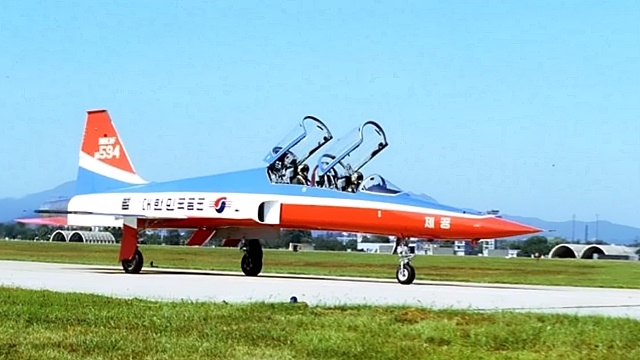
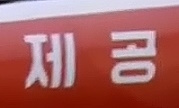 Jegongho inscription on nose
Jegongho inscription on nose
First Korean built
aircraft
Northrop KF-5F in Korean national colours on roll-out.
It received the standard geay
camouflage on transfer to the Korean AF. Photo: Korean Air Lines
Interest
in an upgrade
of the Tigers to extend their operational life was shown
in 1986; the programm began with trial installation in 1988 of an
Honeywell H-423 laser INS and an GEC HUD/WAC on an F-5F. Included in
the specification were also a laser ranger, a data transfer system,
plus (possibly) a new radar. Only
space availability in the front was available and the project was
without follow-on; anyhow, between March 2012
and May 2013, the original USA built ejection
seat on 180 Northrop F-5s was replaced by an British made one,
between March 2012 and May 2013, for a cost of
approximately 46 billion Won
Three
Northrop F-5As were sold in September 1996 to the Philippines
(delivered by ship) for a friendly price of USD 100.00 each,
five additional followed in October 1998. This was in order to
facilitate the sale of the new
KAI AF-50 attack aircraft/advanced
trainer.
Paveway II and Paveway III laser guided bombs were bought to arm both the Northrop F-5E and MDonnell F-4s in 2003; improved air-to-air missiles AIM-9P were also bought.
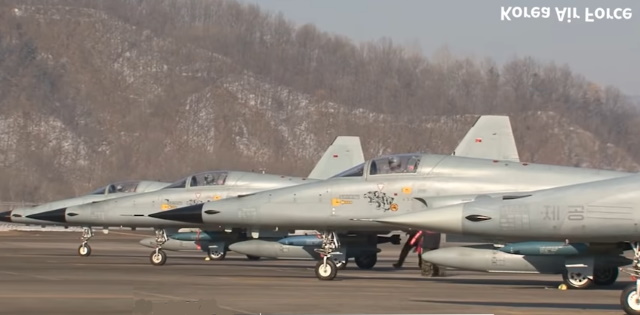

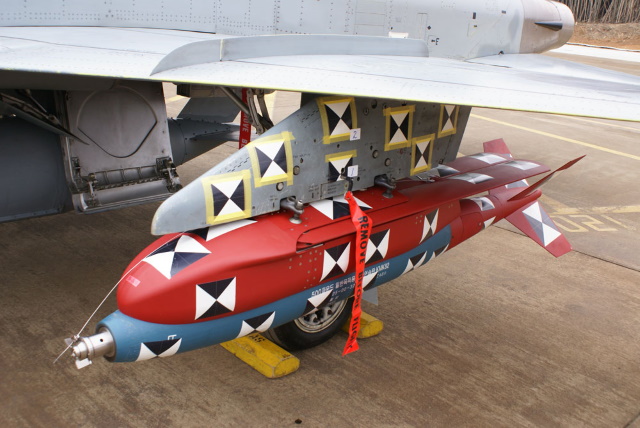 Development KGGB bomb. Photo RO Korea AF
Development KGGB bomb. Photo RO Korea AF
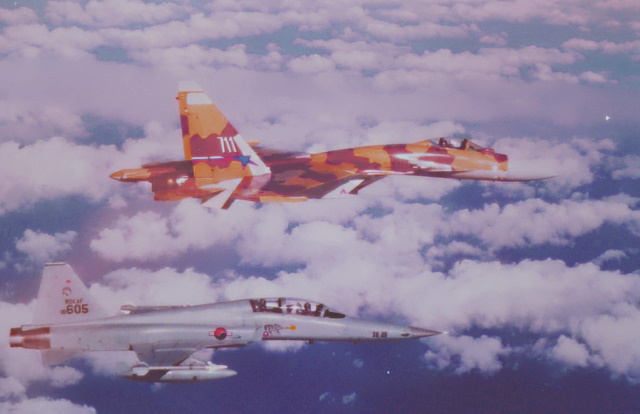 Photo: R Korea AF
Photo: R Korea AF 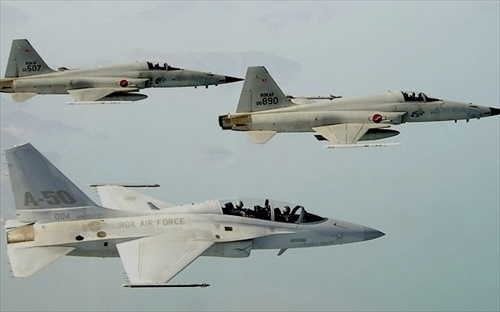 Photo:
KAI
Photo:
KAIGood use of the engines from withdrawn from Nothrop F-5s was found in a new air bases snow-plogging machine, called "Majinga", together with bigger McDonnell F-4s engines, called "Big Majinga".
In
April 2015 the 50th anniversary of Korean Air Force operation of
Northrop F-5 (all versions) was commemorated, contemporarely all
Northrop built Tigers were withdrawn from use. A total of 11 Northrop
F-5s have
crashed between 2000 and 2010.
Units operating KAI/Northrop F-5s in November 2018
Suwon
has two tenant Squadrons (101 Fighter Squadron and 201 Fighter Squadron) both operating Northrop
KF-5E/F Jegpngho (translated as Sky master) produced under licence by
Korean Air back in 80's; another
Squadron (207th Squadron) flying
with directly in USA manufactured aircrafts, disbanded due to its ageing
fleet and subsequently replaced by an McDonnell F-4 Squadron in
2017. Visual difference between the Northrop
and KAI built aircrafts are: the colour of the radome: KAI/Northrop KF-5 gray,
Northrop F-5s black and the shape of the tail fin (no antenna on the
Northrop F-5s).
Approximately 50 KF-5E/KF-5F aircrafts remained in use by md-2020 with the 1st Fighter Wing/206 Squadron.
 Photo: bemjl/KODEF
Photo: bemjl/KODEF
Maintenance on an Northrop KF-5E of the 201st Fighter Squadron
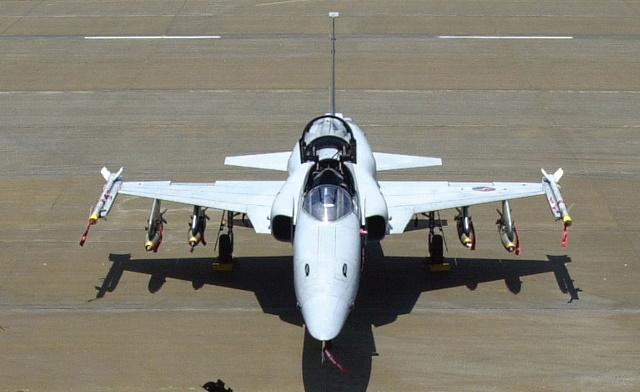
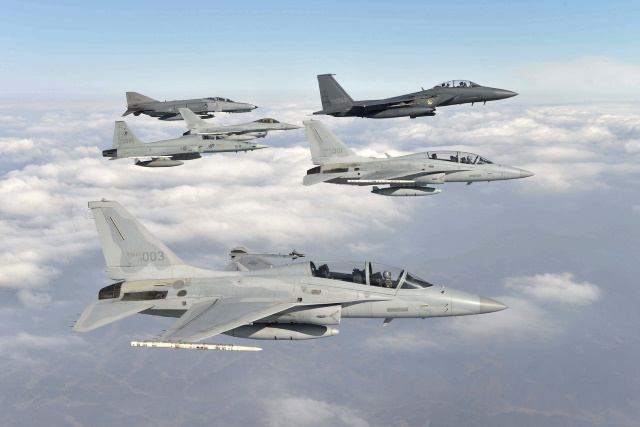
Front view of a fully laden KAI/Northroporthrop of a KF-5E Photo:
Defense Media
Agency/Korea
KAI/Northrop F-5E accompanied by all
fighters/attack aircrafts used by the Korean AF
 Photo: local media
Photo: local media
Unknown Northrop F-5E crashed on
11-02-22 (or 11-01-21?) after taking-off at Suwon AB.
This was the twelvth F-5 crash since 2000.
Delivery of further 20 KAI F-50 foreseen starting in June 2023 was postponed, expected between 2024 and 2026, priority given to export ordes for 48 aircrafts by Poland and 12 by Malysia.